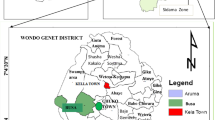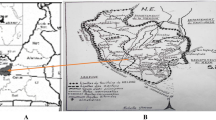Abstract
Anemia and intestinal helminth infections are overlapping health problems in developing countries. This study examined the determinants of intestinal helminth infection and anemia in a human population in Harbu Town, northeastern Ethiopia. A total of 484 individuals provided stool and blood samples as well as information about their sociodemographic characteristics and living practices in a community-based cross-sectional survey conducted between May and June, 2013. Stool specimens were examined for intestinal helminth infections using the Kato–Katz method. While a HemoCue machine was used to measure blood hemoglobin levels, a CareStartTM malaria Pf/Pv combo test was used to test the blood specimens for Plasmodium infection. Out of 484 individuals examined, 15.5% were anemic and 32.0% were infected with intestinal helminths. Plasmodium infection was not detected in any of the study participants. Schistosoma mansoni infection was most common (26.7%) followed by Hymenolepis nana (4.1%). The prevalence of S. mansoni and H. nana infection was greater among school-age children than in pre-school-age children and adults. The prevalence of helminth infection decreased with an increase in monthly income (P = 0.048) and varied among different occupations (P = 0.023). The odds of anemia increased with an increase in the age of individuals (adjusted odds ratio = 1.03, 95% CI = 1.01, 1.06). Hookworm infection was associated with anemia (P = 0.029). In conclusion, intestinal helminth infections and anemia were public health problems among the community of Harbu Town. Increasing age and hookworm infection may increase susceptibility to anemia. Controlling helminth infection may help to reduce the burden of anemia in Harbu Town, Ethiopia.
Similar content being viewed by others
References
Abdi M, Nibret E, Munshea A (2017) Prevalence of intestinal helminthic infections and malnutrition among schoolchildren of the Zegie Peninsula, northwestern Ethiopia. J Infect Public Health 10(1):84-92
Abebe F, Birkeland KI, Gaarder PI, Petros B, Gundersen SG (2003) The relationships between dehydroepiandrosterone sulphate (DHEAS), the intensity of Schistosoma mansoni infection and parasite-specific antibody responses. A cross-sectional study in residents of endemic communities in north-east Ethiopia. APMIS 111(2):319–328
Aemero M, Berhe N, Erko B (2014) Status of Schistosoma mansoni prevalence and intensity of infection in geographically apart endemic localities of Ethiopia: a comparison. Ethiop J Health Sci 24(3):189–194
Alelign T, Degarege A, Erko B (2015a) Soil-transmitted helminth infections and associated risk factors among school children in Durbete Town, northwestern Ethiopia. J Parasitol Res 2015:641602
Alelign T, Degarege A, Erko B (2015b) Prevalence and factors associated with undernutrition and anaemia among school children in Durbete Town, northwest Ethiopia. Arch Public Health 73:34
Alemu A, Shiferaw Y, Ambachew A, Hamid H (2012) Malaria helminth co-infections and their contribution for aneamia in febrile patients attending Azzezo health center, Gondar, northwest Ethiopia: a cross sectional study. Asian Pac J Trop Med 5(10):803–809
Brooker S, Kabatereine NB, Smith JL, Mupfasoni D, Mwanje MT, Snow RW (2009) An updated atlas of human helminth infections: the example of East Africa. Int J Health Geogr 8:42
Chagas DC, Silva AA, Batista RF, Simões VM, Alves MT (2013) Prevalence and factors associated to malnutrition and excess weight among under five year-olds in the six largest cities of Maranhão. Rev Bras Epidemiol 16:146–156
Crompton DW, Nesheim MC (2002) Nutritional impact of intestinal helminthiasis during the human life cycle. Annu Rev Nutr 22:35–59
Degarege A, Erko B (2013) Association between intestinal helminth infections and underweight among school children in Tikur Wuha Elementary School, northwestern Ethiopia. J Infect Public Health 6:125–133
Degarege A, Animute A, Legesse M, Erko B (2009) Malaria severity status in patients with soil transmitted helminths. Acta Trop 112:8–11
Degarege A, Animute A, Legesse M, Erko B (2010) Malaria and helminth co-infections in outpatients of Alaba Kulito Health Center, southern Ethiopia: a cross sectional study. BMC Res Notes 3:143
Degarege A, Animut A, Medhin G, Legesse M, Erko B (2014) The association between multiple intestinal helminth infections and blood group, anaemia and nutritional status in human populations from Dore Bafeno, southern Ethiopia. J Helminthol 88:152–159
Degarege A, Hailemeskel E, Erko B (2015) Age-related factors influencing the occurrence of undernutrition in northeastern Ethiopia. BMC Public Health 15:108
Gwatkin DR, Rustein S, Johnson S, Pande K, Wagstaff A (2000) Socioeconomic differences in health, nutrition and population in Cameroon HNP/Poverty Thematic Group of World Bank, Washington DC
Jardim-Botelho A, Brooker S, Geiger SM, Fleming F, Souza Lopes AC, Diemert DJ, Corrêa-Oliveira R, Bethony JM (2008) Age patterns in undernutrition and helminth infection in a rural area of Brazil: associations with ascariasis and hookworms. Tropical Med Int Health 13(4):458–467
Jayne J, Scrimgeour AG, Polhemus ME, Otieno L, Bovil ME (2011) Dietary and socio-economic correlates of nutritional status in a rural adult Kenyan population. Afr J Food Agric Nutr Dev 11:5035
Leite MS, Cardoso AM, Coimbra CE et al (2013) Prevalence of anaemia and associated factors among indigenous children in Brazil: results from the First National Survey of Indigenous People’s Health and Nutrition. Nutr J 28:69
Mupfasoni D, Karibushi B, Koukounari A, Ruberanziza E, Kaberuka T, Kramer MH (2009) Polyparasite helminth infections and their association to anaemia and undernutrition in northern Rwanda. PLoS Negl Trop Dis 3(9):e517
Pongou R, Ezzati M, Salomon JA (2006) Household and community socioeconomic and environmental determinants of child nutritional status in Cameroon. BMC Public Heath 6:98–119
Pullan R, Brooker S (2008) The health impact of polyparasitism in humans: are we under-estimating the burden of parasitic diseases? Parasitology 135:783–794
Shaw JG, Friedman JF (2011) Iron deficiency anaemia: focus on infectious diseases in lesser developed countries. Anaemia 2011:260380
Viana MB (2011) Anaemia and infection: a complex relationship. Rev Bras Hematol Hemoter 33(2):90–95
WHO (2015) The global prevalence of anaemia in 2011. Geneva: World Health Organization; 2015. Accessed from http://www.who.int/nutrition/publications/micronutrients/global_prevalence_anaemia_2011/en/ on October 10, 2019.
WHO (2020a) Soil-transmitted helminth infections. Accessed from https://www.who.int/news-room/fact-sheets/detail/soil-transmitted-helminth-infections on July 22, 2020
WHO (2020b) Schistosomiasis (bilharzia). Accessed from https://www.who.int/health-topics/schistosomiasis#tab=tab_1 on July 22, 2020
Worku L, Damte D, Endris M, Tesfa H, Aemero M (2014) Schistosoma mansoni infection and associated determinant factors among school children in Sanja Town, northwest Ethiopia. J Parasitol Res:2014792536. https://doi.org/10.1155/2014/792536
WHO (2001) Iron deficiency anaemia: assessment, prevention and control. WHO, Geneva, pp 167–190
Yimam Y, Degarege A, Erko B (2016) Effect of anthelminthic treatment on helminth infection and related anaemia among school-age children in northwestern Ethiopia. BMC Infect Dis 16(1):613
Acknowledgments
We appreciate the support from health officers in Harbu Health Center during data collection. We would also like to acknowledge the study participants for their cooperation and provision of the necessary information during the study.
Funding
This study was financially supported by funds obtained from Wollo University and Aklilu Lemma Institute of Pathobiology, Addis Ababa University.
Author information
Authors and Affiliations
Corresponding author
Ethics declarations
Conflict of interest
The authors declare that they have no conflict of interest.
Ethics approval
The study was conducted after the protocol was approved by the Institutional Review Board (IRB) of the Biology Department, Wollo University. Permission to conduct the study was also obtained from the town administration and the district health office before data collection. In addition, written informed consent was obtained from voluntary participants and parents or guardians for children younger than 18 years during data collection. Study participants who were positive for intestinal helminths were treated with appropriate anti-helminthic drugs free of charge.
Disclaimer
The funding organization had no role in designing this study nor in the collection, analysis, and interpretation of data; in the writing of the report; nor in the decision to submit the article for publication.
Additional information
Section Editor: David Bruce Conn
Publisher’s note
Springer Nature remains neutral with regard to jurisdictional claims in published maps and institutional affiliations.
Rights and permissions
About this article
Cite this article
Hailemeskel, E., Erko, B. & Degarege, A. Community-level epidemiology of intestinal helminth infections and anemia in Harbu Town, northeastern Ethiopia. Parasitol Res 119, 3451–3457 (2020). https://doi.org/10.1007/s00436-020-06864-4
Received:
Accepted:
Published:
Issue Date:
DOI: https://doi.org/10.1007/s00436-020-06864-4




